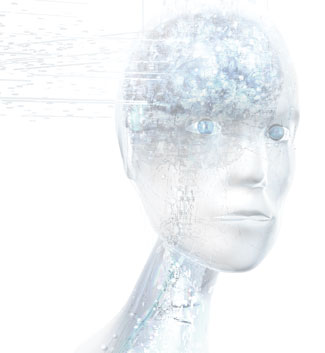Difference between revisions of "Information about the Singularity"
m (moved IEEE Singularity to Information about the Singularity) |
|||
| Line 1: | Line 1: | ||
| − | =Singularity= | + | =Connections with Susan Blackmore?= |
| + | |||
| + | <center><videoflash>fQ_9-Qx5Hz4</videoflash></center> | ||
| + | |||
| + | * Interesting discussion of replicators, and "temes", that are related to the Singularity. | ||
| + | |||
| + | =The Singularity in IEEE= | ||
[[Image:IEEESingularity.jpg]] | [[Image:IEEESingularity.jpg]] | ||
Revision as of 11:17, 12 November 2010
Connections with Susan Blackmore?
- Interesting discussion of replicators, and "temes", that are related to the Singularity.
The Singularity in IEEE
The following articles on the singularity appeared in IEEE Spectrum, which dedicated the whole issue to the Singularity, June/July 2008 [1].
- Signs of the Singularity, Vernor Vinge.
- This paper is 6 pages long. It is the paper that introduces the whole issue of Spectrum. It is written by Vernor Vinge who coined the term Singularity in 1982, at an AI conference. He expect the singularity to come as some combination of 5 scenari.
- the AI scenario: superhuman AI
- the IA scenario: Intelligence Amplification: human intelligence is enhanced via computer interfaces
- the Biomedical scenario: human intelligence is enhanced by improving neurological activity
- the Internet scenario: Humanity + computers + Internet is considered a superhuman intelligence
- the Digital Gaia scenario: the network of embedded processors becomes sufficiently effective to be considered intelligent.
- This paper is 6 pages long. It is the paper that introduces the whole issue of Spectrum. It is written by Vernor Vinge who coined the term Singularity in 1982, at an AI conference. He expect the singularity to come as some combination of 5 scenari.
- Quote: I base the possibility of hard takeoff partly on the known potential of rapid malcode (remember the Slammer worm?) but also on an analogy: the most recent event of the magnitude of the technological singularity was the rise of humans within the animal kingdom. Early humans could effect change orders of magnitude faster than other animals could. If we succeed in building systems that are similarly advanced beyond us, we might experience a similar incredible runaway.
- Can Machine Be Conscious?, Christof Koch and Giulio Tononi.
- This is a 7-page article, written by Christof Koch and Giulio TOnoni. THey are neuroscientists who have studied consciousness. They DO think that consciousness will eventually be artificially created.
- Their approach is to take away different brain functions and show that without them, we can still have consciousness. Memory, sensory, etc., are not required. They refute that, as many think, consciousness is selective attention and show that recent evidences show to the contrary.
- Nice quote: Information is defined as the reduction of uncertainty that occurs when one among many possible outcomes is chosen.
- They refer to the work of Tomaso Poggio at MIT in vision system based on hierarchical multilayered maps of neronlike elements that perform admirably at learning t categorize real-world images, and rival state-of-the-art machine-vision systems.
- This is an 8-page paper written by Robin Hanson at George Mason U. Its claim is that if we look at the past economic data on the economic growth of the world through the past several 1000 years, we are at a point where there should be a new singularity soon. Over the past 7000 years the world product doubled its output every 900 years. Recently the doubling of products occurs every 15 years. That's the industrial revolution.
- There were two past main economic-based transitions:
- from the hunting and gathering period to the agricultural period
- from the agricultural period to the industrial period
- There were two past main economic-based transitions:
- His point is that the computer in itself is not going to create the new revolution. It is more the sudden area of problems that we'll be able to solve that will make more and more intelligent computers solving more and more problems.
- The new revolution should occur around 2075
- Goes in a bit of science fiction at the end of the paper. A bit scary...
- http://cs.smith.edu/~thiebaut/research/singularity/ieee_spectrum__i,_rodney_brooks,_am_a_robot.pdf
- http://cs.smith.edu/~thiebaut/research/singularity/ieee_spectrum__of_two_minds.pdf
- http://cs.smith.edu/~thiebaut/research/singularity/ieee_spectrum__ray_kurzweil_and_neil_gershenfeld__two_paths_to_the_singularity.pdf
- This paper is 1 1/2 pages. Introduces David Dalrymple, now 16 and grad student at MIT, who is working with Gernshefeld. Darlymple works on question of whether Gernshenfeld and Kurzweil are both predicting the same thing. Seems that answer is Yes.
- Quote: “The result for me has been an increasingly close integration of physical science and computer science, bringing the programmability of the digital world to the physical world. But whether computers are merged with reality or reality is merged with computers, the result is the same: the boundary between bits and atoms disappears."
- http://cs.smith.edu/~thiebaut/research/singularity/ieee_spectrum__reverse_engineering_the_brain.pdf
- http://cs.smith.edu/~thiebaut/research/singularity/ieee_spectrum__rupturing_the_nanotech_rapture.pdf
- http://cs.smith.edu/~thiebaut/research/singularity/ieee_spectrum__singularity_index.pdf
- http://cs.smith.edu/~thiebaut/research/singularity/ieee_spectrum__singular_simplicity.pdf
- http://cs.smith.edu/~thiebaut/research/singularity/ieee_spectrum__tech_luminaries_address_singularity.pdf
- http://cs.smith.edu/~thiebaut/research/singularity/ieee_spectrum__the_consciousness_conundrum.pdf
- http://cs.smith.edu/~thiebaut/research/singularity/ieee_spectrum__un-assuming_the_singularity.pdf
- http://cs.smith.edu/~thiebaut/research/singularity/ieee_spectrum__waiting_for_the_rapture.pdf
- http://cs.smith.edu/~thiebaut/research/singularity/ieee_spectrum__who's_who_in_the_singularity.pdf
